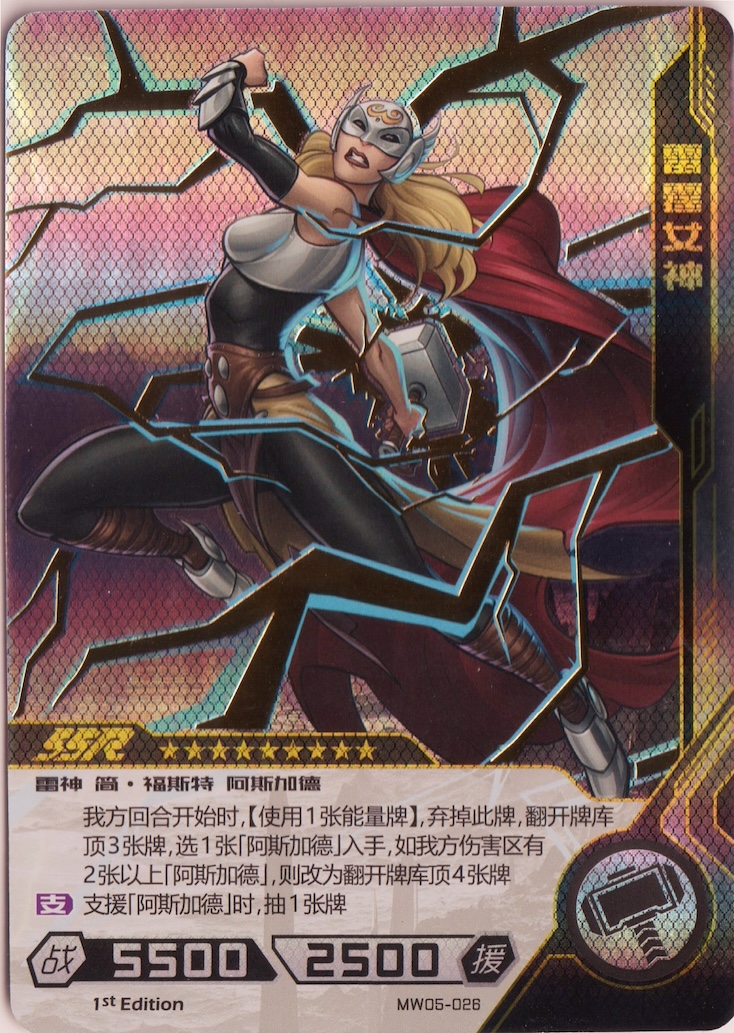Kayou’s fantastic Marvel Hero Battle sets are already well known around the world as some of the best looking Marvel trading cards available – but do you know the Hero Battle rules? Easily beating the base sets released by western companies like Upper-Deck in both cost and quality. Only the top tier western sets start to compete and they cost many times more than a box of Hero Battle would. But did you know they were part of a full blown TCG product too? I’ve translated all the rules, and many cards, in this post I’ll teach you how the Marvel Hero Battle rules!
Table of Contents
- The Players Mat
- Hero Battle Rules: Anatomy of a Card
- Card Effects and Win Conditions
- Deck Building and Game Setup
- Phases of a Turn
- Starting a Battle
- Hero Battle Rules: Supporters
- Battle: Deciding a Winner
- End of Turn Upkeep
- Hero Battle Rules: On card effects
- Hero Battle Rules Conclusions
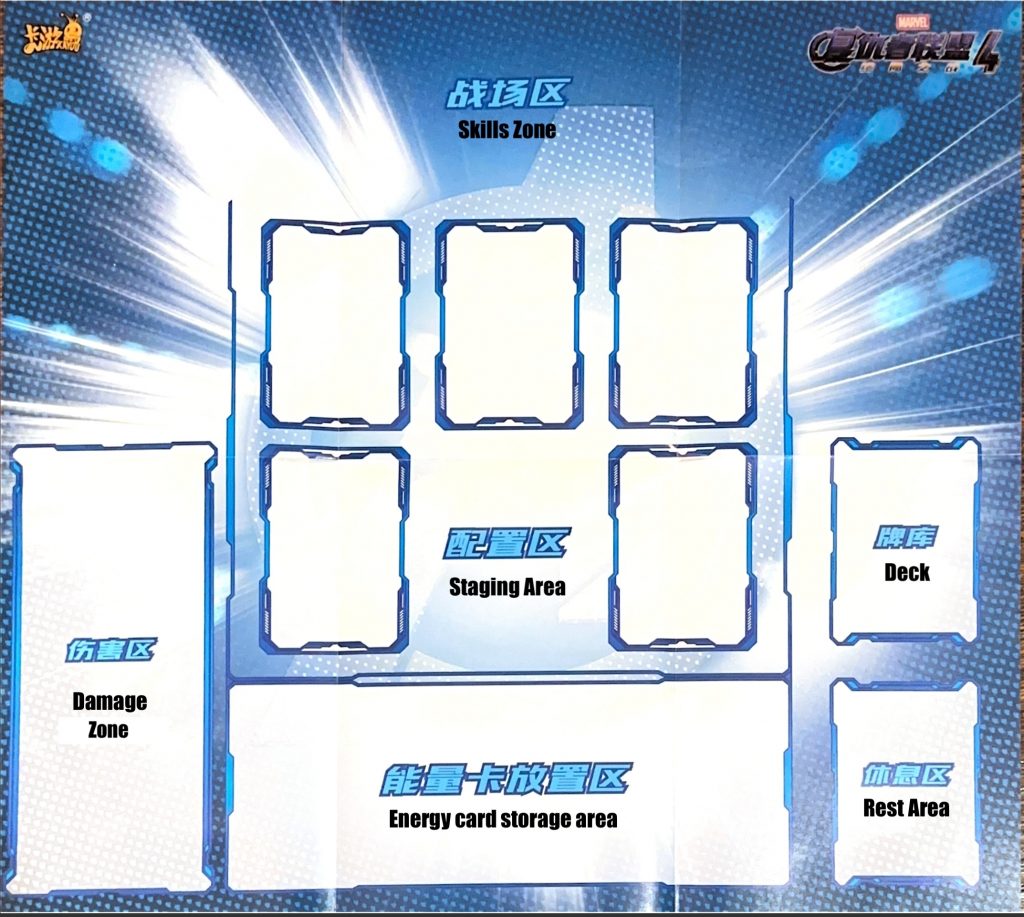
The Players Mat
All good TCGs start with your table layout. In Pokemon TCG that’s where you put your energy cards, you main Pokemon and your reserves. In Magic The Gathering this is where your land cards go, your graveyard, artifacts and summoned creatures. You don’t need to use a mat to play, but it helps a lot when first starting out. Without on you’ll end up forgetting where you put which type of card.
Marvel Hero Battle is no different, the game is complicated enough that at least following the mats layout for your first few games will help a ton. You can get your own mat by buying one of the starter kits, they only cost 12-14$ and come with some incredible promo cards. They also come with 2 fat packs of set 1 cards, these packs are loaded with SSRs and a guaranteed LR so… yeah well worth picking one up.
To help you understand the Hero Battle rules, take a look at my translated mat above. Each of those zones will come up as we talk through the rules, so knowing where each is on the table will help. We’ll talk about each spot and what it does when they come up in the rule book itself.
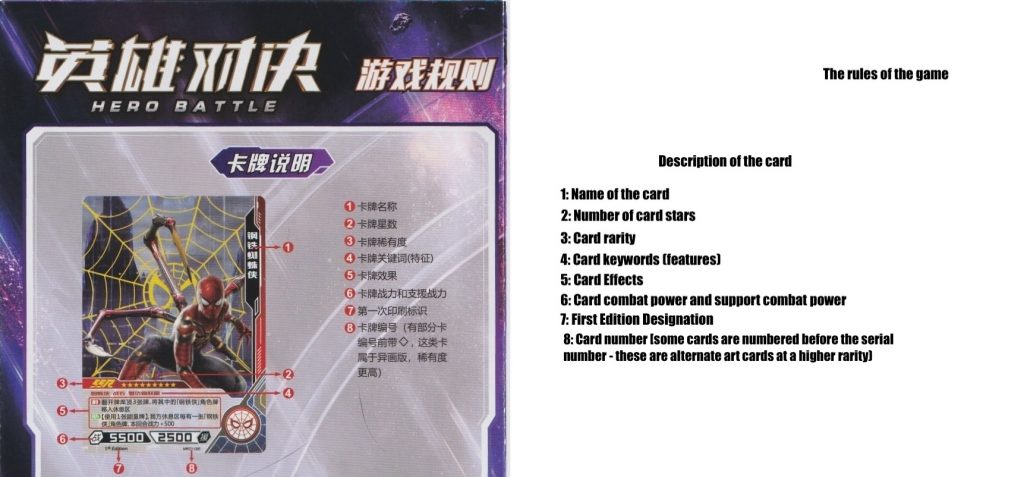
Hero Battle Rules: Anatomy of a Card
Let’s start by examining the various things that can appear on a card. Starting on the side there is the name of this character, Iron Spider Man in this case – which is 钢选蜘蛛供 in Mandarin. I recommend you get an app like Google Translate on your phone, you can point it at the cards and it will translate things for you. Just understand that Mandarin often uses poetic descriptions to express concepts. So you have to use your own intuition a bit to nail down the translations. That’s what I’ve done on all these translations.
Moving on, item 2 is the star count for the card. Many of these Asian trading cards share a star system like this. It’s sort of like a rarity/power level system – but you don’t really need to consider it. The star system is not used in game play or deck building. Neither is the rarity, there are no restrictions on rarity levels.
The card keywords do matter. You will need to translate these, or at least pattern match the characters. This is where you will find things like what team they belong to, which often matters for rules and deck building. Next are the effects of the card, these are different on every card. Some have none, some have 2 or 3 effects.
Finally those big numbers at the bottom are the “Combat Power” on the left, and the “Support Power” on the right. These are the most important values in the game, we’ll be talking a lot about them in the battle section. Then there are some serial numbers for the cards, a “1st edition” mark which is not enough to make a card unique on it’s own. Some cards have high-rarity alternate art versions, those are unique cards and have a distinct serial number.

Card Effects and Win Conditions
The next section of the Hero battle rules explain the card effects. This is the meat and potatoes of the game. Just like a good magic card, these cards all have unique rule-bending effects. It’s these card effects that give the game so much strategic depth!
Yellow effects active when a character enters the stage, typically that happens when you swap your support and attacking characters when you win a battle. Red effects happen when cards are flipped. Most cards in this game enter the board face down, and are flipped later via other rules and effects. Blue effects happen on attack, these are very common on cards.
Green effects happen when your character is defending an attack, also a very common effect to find. Purple are for support, when you attack or defend you will also choose a card to be your supporting attacker/defender. That card is allowed to activate it’s purple effects. Black effects happen when you win a battle, and white is when you lose. Losing isn’t always bad though, some losing effects give you benefits like drawing cards or gaining energy.
Those red statements at the very bottom are the win conditions. You win this game is your opponent ever has 5 characters in their damage zone. Characters go there when they lose a battle, but can be retrieved by other cards. Then if you mill the other player out, you win. “Milling” is the concept of forcing the other player to draw cards they don’t really want to draw.
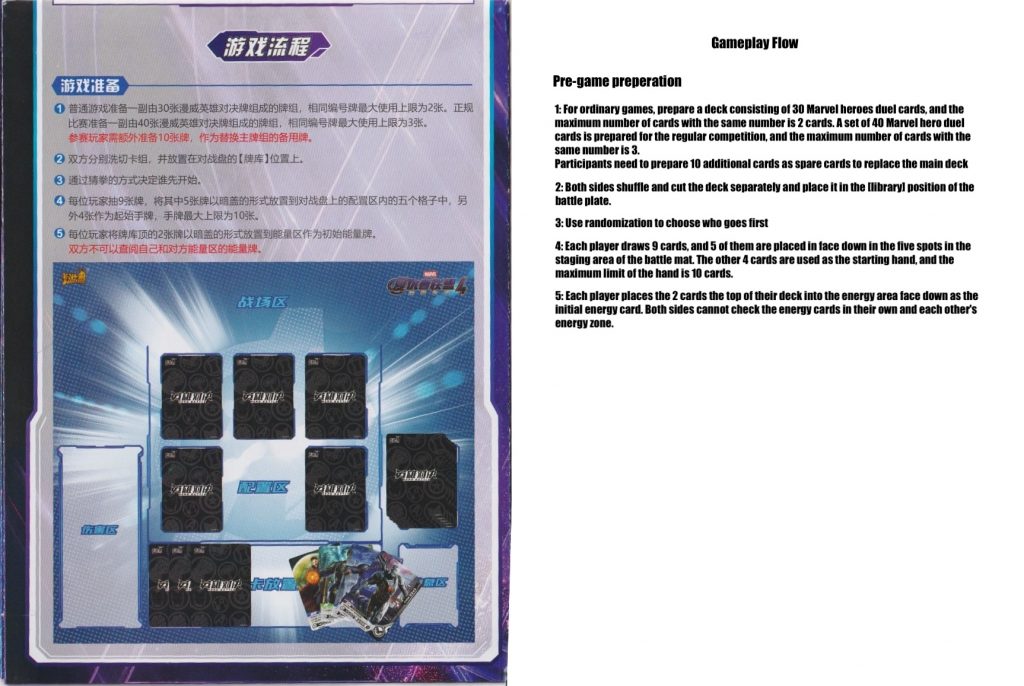
Deck Building and Game Setup
Like other TCGs building your deck is a primary component of your strategy. There are some limitations though. If you are playing a casual game with friends then you want 30 card decks with no more than 2 copies of the same card. There are no other restrictions on rarity or star level – but go easy on your little brother please. If you ever happen to play in a tournament, you’ll want a 40 card deck with up to 3 copies of the same card. Tournament players also want a 10 card side board to swap out their main deck between games against the same player.
Once you and your opponent have built decks, shuffle them and place them on your respective “Deck Zone” spots, “Deck” is often translated as “Card Library” from Mandarin. Now each player draws 9 cards into their hand, not showing the other player of course. Pick 5 of those to place face down into your “Staging Area”, these are your initial attackers and defenders. They are face down though, only you know which are where – your opponent does not know.
Use randomization to choose who goes first. The 4 remaining cards are your starting hand, your hand can never grow above 10. If you have more than 10 cards in your hand you will not get to draw a new one on turn start.
The last part of setup is preparing your energy. This TCG does not use dead energy cards, like land or literal energy cards in other TCGs. Instead your characters are your energy! They go into the energy zone face down and are used to activate abilities on other cards. You and your opponent are never allowed to look at face down cards in the energy zone. There are ways to flip energy cards over via other card effects.
So to get that started take the top two cards from your deck, not your hand, and move them to the energy zone. Keep them face down and don’t look at them. A big part of this game is having your key cards sitting in the energy zone and figuring out how to get them onto the board again.
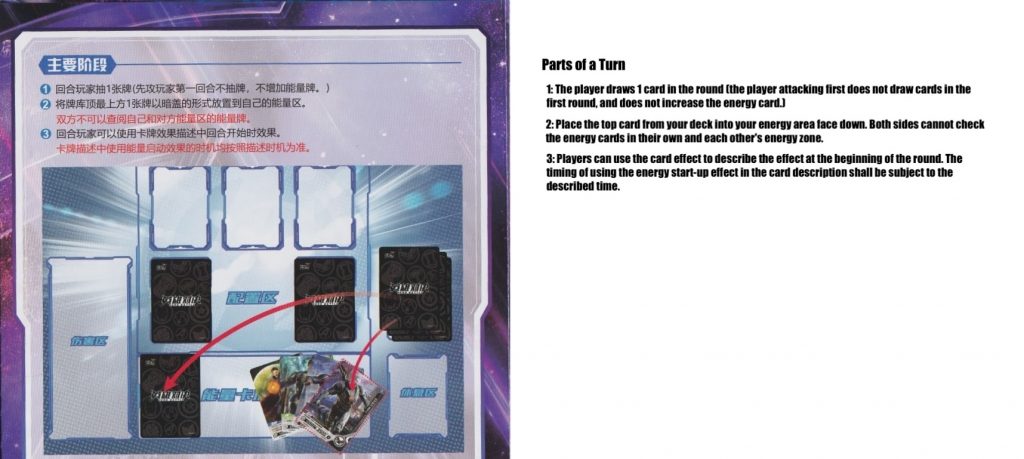
Phases of a Turn
When you start your turn always to the following two upkeep actions. Draw a card, assuming you don’t have 10 cards in hand already in which case skip this. Then move the top card of your library into your energy zone. The only twist is that if you are going first in the game then you don’t do this, you have to start with your 4 hand cards and 2 energy.
Now before anybody declares a battle to move the game forward, each player gets a chance to activate effects on any of their cards. Some cards have “beginning of the round” effects, these don’t have color symbols. I’ll show an example of this type of card at the end of this post. These cards can be in your hand, or revealed anywhere on the board.

Starting a Battle
It isn’t clear if this phase is optional or not, but I can’t imagine playing this game and not wanting to fight. After start of turn effects are all fully resolved, the player who’s turn it is will declare a battle. This is done by choosing a card from your staging area and a card from the opponents staging area.
Remember though that staging area cards all hit the table face down. So unless you’ve done something to flip them already you will be picking blind. You can look at your own staging area to remember who is where – but you cannot look at your opponents face down staging area cards.
Once you’ve picked both players flip those cards if they were face down. Then immediately decided if you want to use on-attack or on-defend effects respectively. The attacking player settles their effects first, meaning your attack effect may defeat the opponent before they even get a chance to resolve their effects!
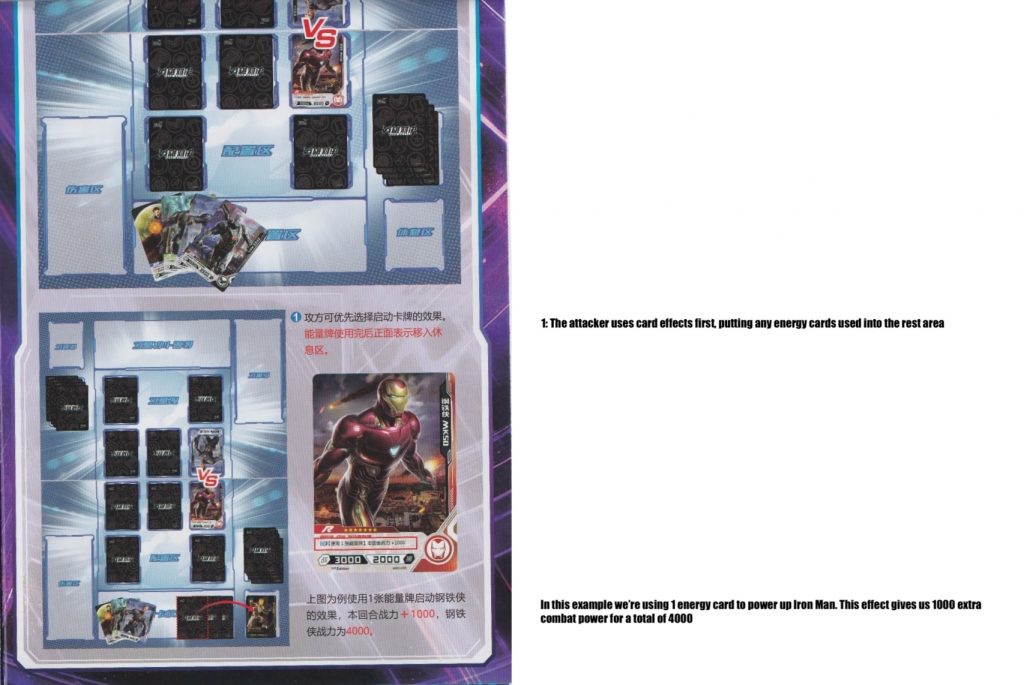
The fourth page of the Hero Battle rules book is just going over an example of attack effects. When you use an effect you move the required energy into the “Rest Zone”. When this happens the cards flip over, so you can now see what they were and know what is missing from your deck – important strategic information.
The example then is Iron Man, the R version, this card has 1 blue “on attack” effect. That effect costs 1 energy, so if you don’t have that you can’t use it. If you do, move one of your energy cards to the rest area and flip it face up it wasn’t already. Then Iron Man gives you 1000 extra combat power. So if Iron Man is itself attacking – it now has 4000 power.
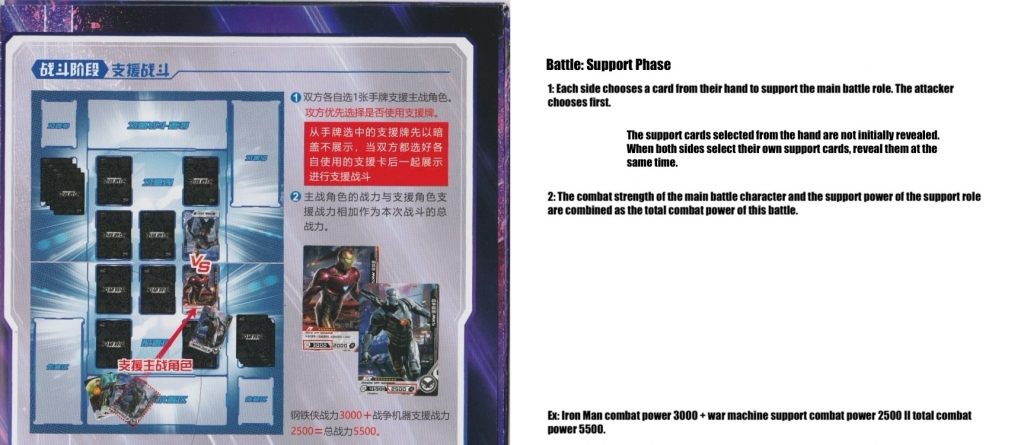
Hero Battle Rules: Supporters
I know this is a long post, but I’m trying to give you a complete picture of these rules in a single article. The concept of a “Supporter” is really important to the strategy of this TCG. Each side, attacker and defender, chooses a support card from their hand. These cards are chosen simultaneously – neither side should know who the other side picked until both are revealed. That said, the attacker should pick first but keep their choice secret until the defender also picks.
Automatically the “Support Power”, or left hand number on the supporter card is added to the combat power of your main attacker or defender. So in the example shown on this page, the attacker is Iron Man with 3000 “Combat Power”. If you then pick War Machine to be the supporter, that will add 2500, the “Support Power” on the war machine card. This costs no energy and happens automatically on picking a supporter.

Battle: Deciding a Winner
Once attack/defend effects are resolved, and supporters have been revealed and their effects have been resolved it’s time to pick a winner. In Marvel characters are never killed, just injured, and this TCG uses the same concept. Losing a battle doesn’t mean your character is gone from the game.
Instead, if you lose a battle, as either the attacker or the defender – you main attacker/defender moves to the damage zone face-up. Your supporter then moves to the rest area, this leaves one of your staging area slots empty. This is not automatically refilled, you will need to use the round start/end effects of cards in your hand to refill that spot. Effects of revealed cards on the board can also be used for this purpose.
If you won – congratulations! You are now subject to one of the coolest and most strategically interesting aspects of the game. You must move your chosen support character to the staging area slot that your main character was in. Your main character then moves to the rest area. This forces you to really think about supporter choices, you might be tempted to pick a supporter with very high “Support Power” – but if they have low Combat Power… well they are now subject to attack by your opponent.
Imagine if in magic you had cycle cards to your graveyard after each attack and replace it with a card from your hand? This would drastically change the flow of the game! Personally when I learned about this aspect of the Hero Battle rules, I fell in love with the game. This type of forced swap is exactly what a TCG like this needs to build that risk/reward aspect to incredible heights!
Finally, in the case both attacker and defender end up with equal Combat Power, both treat that battle as a loss. Both attacker and defender go to the damage zone. Both supporters move to the rest area.
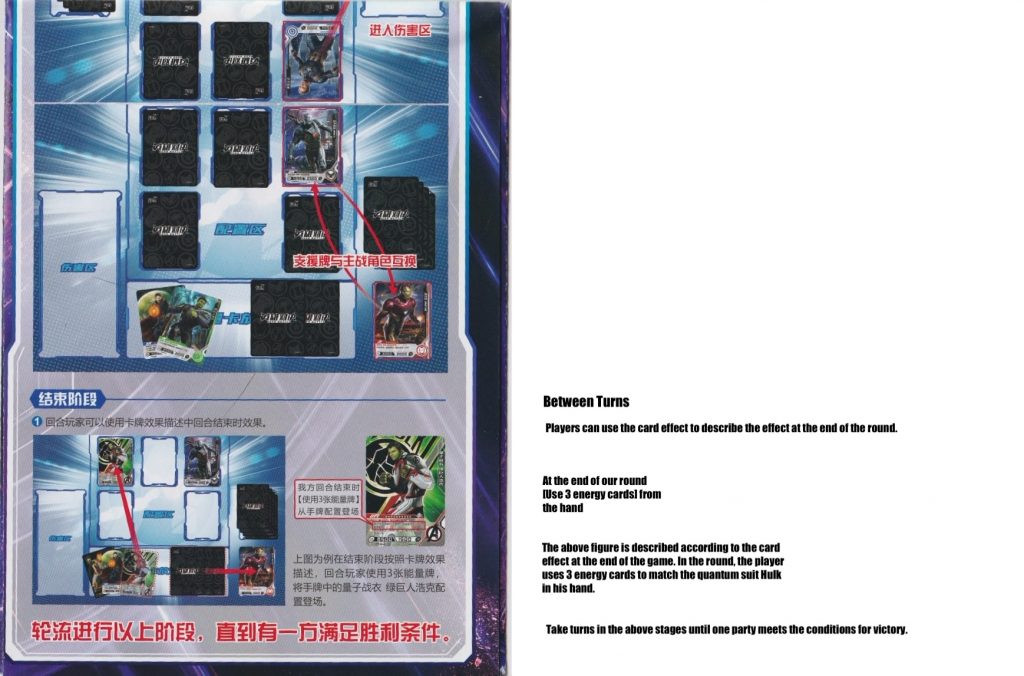
End of Turn Upkeep
When the battle ends, so does your turn. Before you opponents starts though – both players should resolve and “end of round” effects on their revealed or hand cards.
In the Hero Battle rules, they use the example of Quantum Suit Hulk. This card can be deployed to your staging zone. But it can only deploy if you have 3 energy to spend. This is a powerful effect as without effects like this you will be left with a less effective fighting force.
That big red text at the bottom just says that the game continues, turn after turn, until either of the two win conditions are met. Remember those are having the opponent with 5 cards in their damage zone. Or milling the opponent out of cards such that they can no longer draw from their deck.
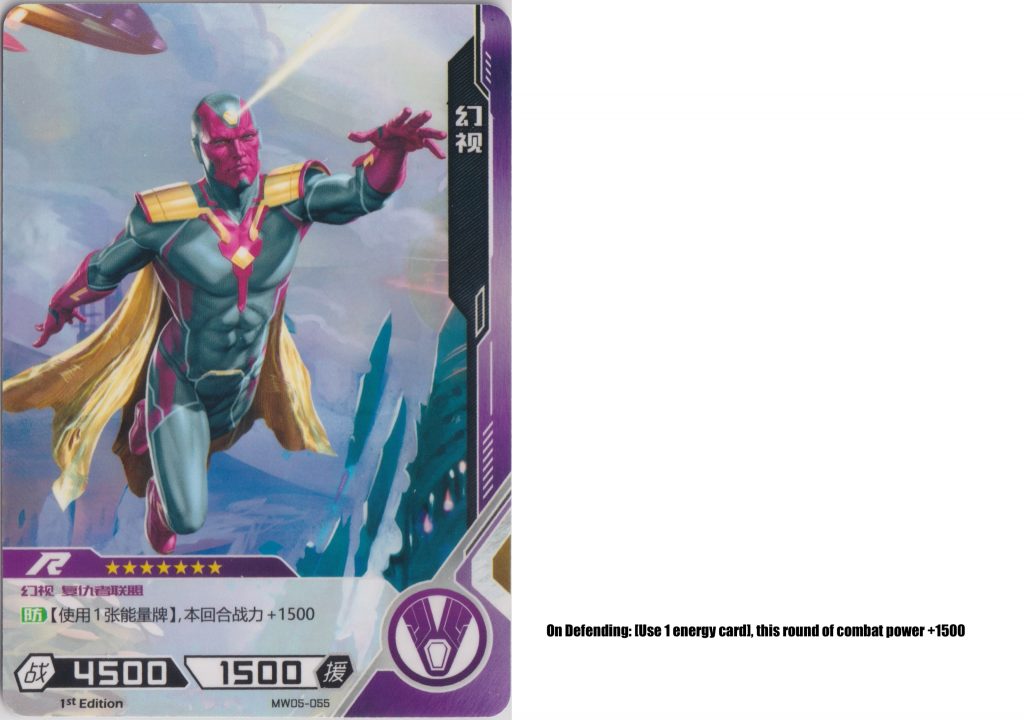
Hero Battle Rules: On card effects
If you choose to play this game, you will need to actively translate all of the effects on the cards you and your opponent use. Fortunately the Mandarin used on these is at a low grade school level. Any translation app can easily get you close enough that your intuition can fill in the rest. To help you get started I’ve personally translated a few cards here as a demonstration.
Let’s start with this Vision R, MW05-055, this card is a great defender! It has high Combat Power, so if the opponent chooses to attack this they will need to overcome at least 4500. If you also have 1 energy to spend you can increase that by 1500. That means your opponent would need to beat 6000(!) combat power, no easy task. Vision can be a formidable defender if you have some spare energy.
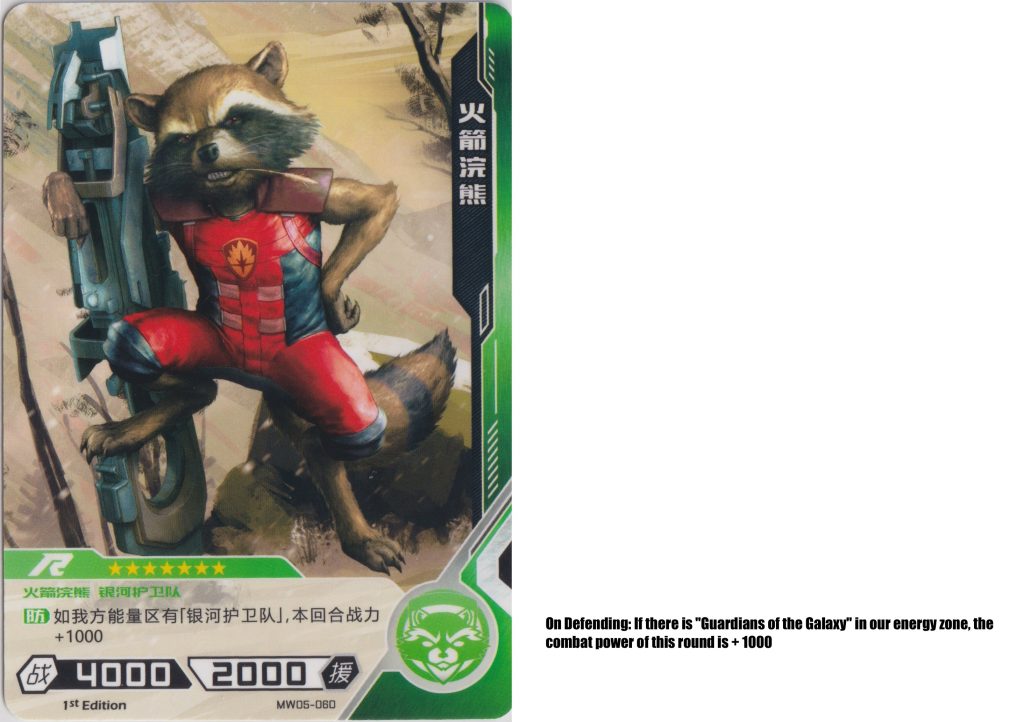
Rocket Raccoon here is similar, also primarily a defender. This card however introduces us to card “Team”. Cards can have a keyword on them indicating their team, such as “Guardians of the Galaxy”. Generally you’ll just know if you know these characters, but use your translation app if you don’t. Keywords are those characters under the rarity and star marks, but above the effect cards. In Rocket’s case you need a “Guardians” card revealed in your Energy Zone. Face down cards don’t count for this, so you must have already flipped something in your energy area. If you meet the criteria – you get +1000, without spending any energy. Really nice!
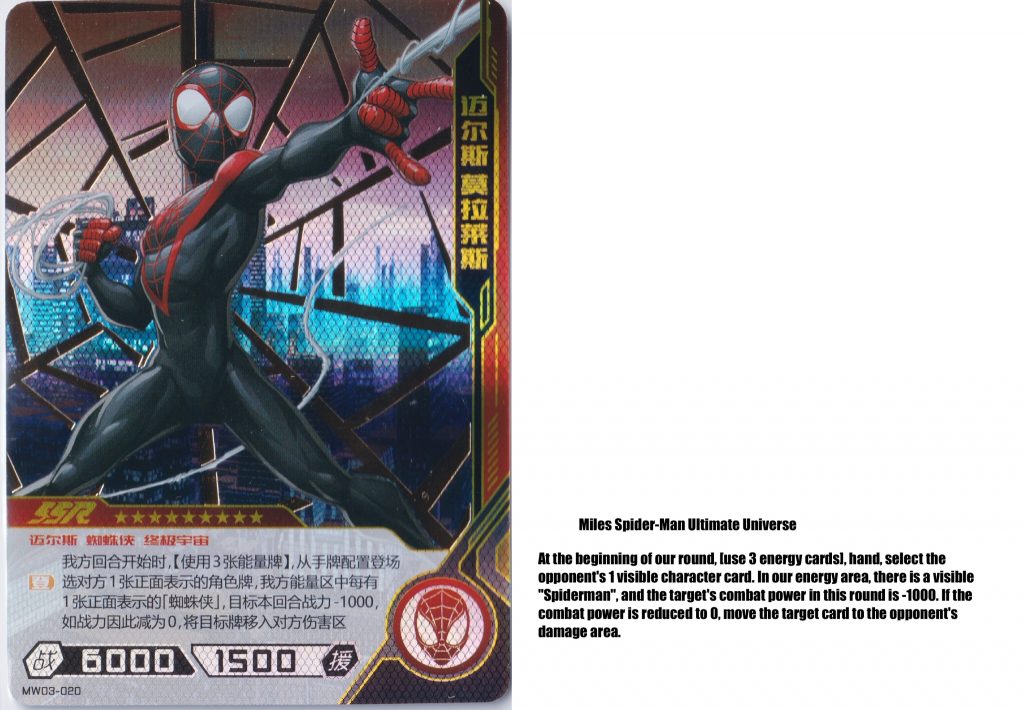
Moving into something more complex, Ultimate Spider-Man here has one of those nice “Beginning of Round” effects. This one is especially interesting as it has the potential to defeat an opponent card without declaring battle. To make that happen you’d need to spend 3 energy and also have a spider-man card revealed in your energy zone. If this card is revealed in the energy zone, it counts for that condition! It’s not easy, but if you can do this, and the opponent happens to have a low combat power card in staging – you can just insta-defeat that card.

Let’s look at one more, than it is time to wrap this post up. This Jane Foster card has two effects. One “Beginning of the round” effect that only works if it is your turn. In that case, you’ll have a chance to look at the top 3 or 4 cards in your deck (library) and take any “Asgard” team card you find there. That means if you built your deck with this card in mind you may be drawing an extra card of your choice that turn!
The card has a second effect to, if you choose it as the supporter of an “Asgard” team attacker/defender – then you get to draw another card. Effects like this are what make the gameplay dynamic and interesting.
Hero Battle Rules Conclusions
OK, wow, so the Hero Battle rules are so much better than I expected. At first glance I really though this would be just another light strategy game like Pokemon TCG. In fact, this is a really interest TCG strategically, and that is coming from somebody who has studied TCG design for 20+ years. This rule set has the potential to beat even a game like MTG given the right mix of card effects and an equally matched opponent.
If anybody out there wants to try and put a game together let me know! I’d love to try and put a deck together and struggle through a game, preferably with somebody who is also a Mandarin novice – I don’t want to just get destroyed by some master.
So there you have it, we’re not just about ripping packs here. We want to add to the hobby, teach you about what you are buying and try to teach you what these cards are all about. Mandarin really isn’t that hard, and modern translation apps make it trivial.
